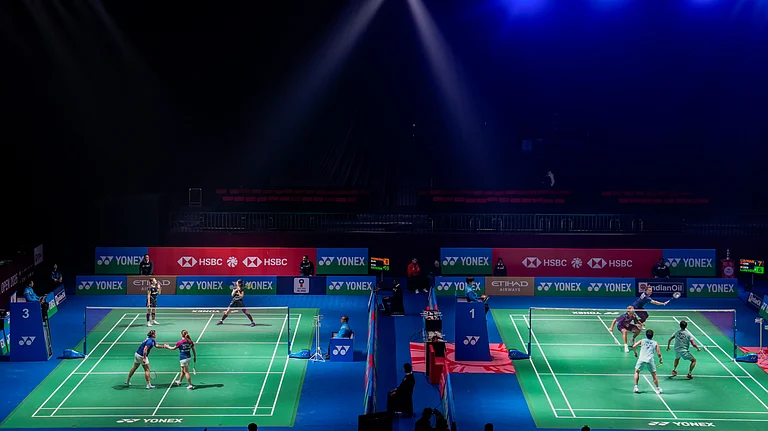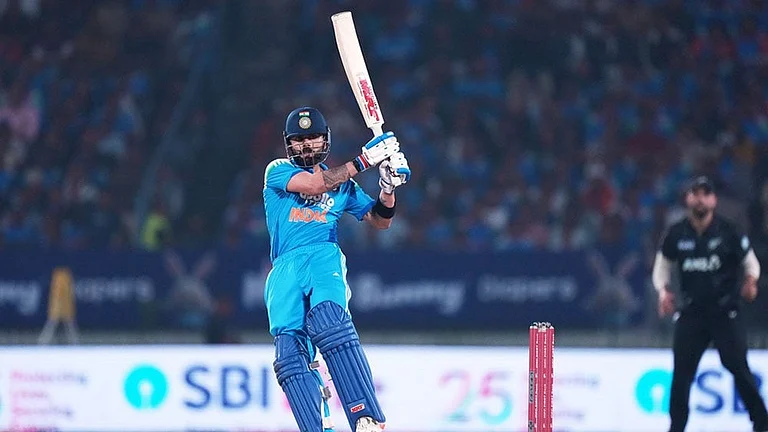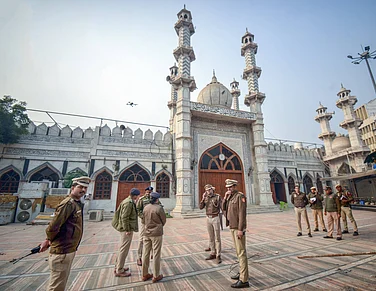The Indian space programme has been in transition for over two decades now from using space primarily for ground applications to exploring space and the celestial bodies. Chandrayaan-3 is one more ambitious step in that direction.
Chandrayaan-3 is set to be launched into space at 2:35 pm on Friday (July 14) from Satish Dhawan Space Centre, Sriharikota, Andhra Pradesh.
Chandrayaan-3, the successor of Chandrayaan-1 and -2, is set to land at the South Pole of the Moon where no spacecraft has landed before. This is one of the main features of the mission as it would probe an area that’s so far unexplored.
Space scientist Sudip Bhattacharyya tells Outlook that landing on the South Pole of the Moon would be a “great achievement”.
“Being the first to go to the South Pole will certainly be a great achievement, and would also be useful for technology demonstration. Basic but the first scientific investigation there and perhaps also to establish some right in that important region,” says Bhattacharyya, Professor, Department of Astronomy and Astrophysics, Tata Institute of Fundamental Research (TIFR).
The bold landing on Moon’s South Pole
Chandrayaan-3 is headed to where no one has been before — the South Pole of the Moon. For a maverick space agency like the Indian Space Research Organisation (ISRO), which has pioneered low-cost space missions and commercial launches, Chandrayaan-3 could appear like a natural step after Chnadrayaan-1 and -2.
The true boldness of the mission to the Lunar South Pole, however, lies in the fact that the mission was planned, designed, and launched within just four years of Chandrayaan-2 that ended in a partial tragedy. The lander, Vikram, crashed on the surface of the Moon and was lost. The orbiter, however, was placed successfully in the Moon’s orbit and remains functional to this day.
Prime Minister Narendra Modi was seen consoling a visibly shaken ISRO chief K Sivan at the time. He said the best of the Indian space programme was yet to come. Today, we are one step closer to the realisation of that statement with Chandrayaan-3.
The Chandrayaan programme has a storied legacy. Earlier in 2008, Chandrayaan-1 had impacted —an intentional controlled crash— on the South Pole of the Moon and a US-made instrument aboard confirmed the presence of water there.
The South Pole of the Moon is also the place where the Artemis-III mission of the United States would land in the next few years. It would be the first time humans would return to the Moon in over five decades.
The Chandrayaan-3 mission could open a whole new avenue of international space cooperation as it would provide crucial insights into an unexplored region of the Moon which would be studied keenly by all the space agencies, including the American NASA, the Russian Roscosmos, and the Japan Aerospace and Exploration Agency (JAXA), says space policy researcher Pranav R Satyanath.
Chandrayaan-3 also comes at a time when the world is witnessing the dawn of the New Space Age where the Moon is no longer a destination but a stepping stone to Mars and beyond. Several voices say it’s not a matter of if but when humans would become an interplanetary species. Interestingly, the phrase finds a mention in ISRO’s vision.
“Chandrayaan-3 consists of an indigenous lander module (LM), propulsion module (PM), and a rover with an objective of developing and demonstrating new technologies required for interplanetary missions,” says ISRO on its website while describing Chandrayaan-3.
Chandrayaan-3 mission objectives
The Geosynchronous Satellite Launch Vehicle Mark-3 (LVM-3) is set to blast off from the Satish Dhawan Space Centre, Sriharikota, Andhra Pradesh, at 2:35 pm on Friday (July 14). The landing on the Moon is expected to take place towards the end of August.
Once on the Moon, the lander and rover will carry out experiments for 15-Earth days.
Chandrayaan-3 will have seven scientific payloads with unique purposes. These payloads are divided among the three elements of the mission — the propulsion module, the lander, and the rover.
As per the ISRO, the stated task of each of the seven payloads is:
Lander payloads
1. Radio Anatomy of Moon Bound Hypersensitive ionosphere and Atmosphere (RAMBHA) Langmuir probe (LP): To measure the near surface plasma (ions and electrons) density and its changes with time.
2. Chandra’s Surface Thermo Physical Experiment (ChaSTE): To carry out the measurements of thermal properties of the Lunar surface near the polar region.
3. Instrument for Lunar Seismic Activity (ILSA): To measure seismicity around the landing site and delineate the structure of the Lunar crust and mantle.
4. LASER Retroreflector Array (LRA): It is a passive experiment to understand the dynamics of the Moon system.
Rover payloads
1. LASER Induced Breakdown Spectroscope (LIBS): Qualitative and quantitative elemental analysis and to derive the chemical composition and infer mineralogical composition to further our understanding of Lunar-surface.
2. Alpha Particle X-ray Spectrometer (APXS): To determine the elemental composition of the Moon’s soil and rocks around the Lunar landing site.
Propulsion module payload
1. Spectro-polarimetry of Habitable Planet Earth (SHAPE): Future discoveries of smaller planets in reflected light would allow us to probe into a variety of exoplanets which would qualify for habitability (or for presence of life).
With such ambitious mission objectives, Chandrayaan-3 is set to lay the groundwork for the next phase of the Indian space programme. For some time now, ISRO has been in talks with the Japanese space agency for a Mars mission. The success of Chandrayaan-3 in the uncharted regions of the Moon will boost Indian credentials at the world stage.
What’s next for the Indian space programme?
For the first five decades, the Indian space programme was largely personality-driven and was influenced by the likes of Satish Dhawan, Vikram Sarabhai, and UR Rao, says Pranav R Satyanath, a space policy researcher at the think tank Council for Strategic and Defense Research (CSDR).
During this time, the focus was on the ground-based applications of space, such as launching satellites for the purpose of television, telecommunication, mapping, weather research, etc. The agency did not have a space-oriented approach even as the United States and the erstwhile Soviet Union were in a space race for decades.
Then, such an approach began to change from the early 2000s and the Indian space programme began to look at the Moon and beyond, says Satyanath.
Satynath says Chandrayaan-3 is not a photo-op and the broader Chandrayaan programme has already captured international attention.
He tells Outlook, “Chandrayaan-3 is not a photo-op. It’s going to be a critical component of international cooperation and a demonstration of Indian achievements and engineering prowess. Even Chandrayaan-1 that confirmed the presence of water on the Moon’s South Pole did so with international cooperation as while the spacecraft was Indian, the instrument that actually confirmed water’s presence was made by NASA's Jet Propulsion Laboratory (JPL).”
Satyanath says that there have been internal suggestions in the US government to use the orbiter of Chandrayaan-2 in place of their own ageing Lunar Reconnaissance Orbiter that was launched in 2009.
The future prospects of the Indian space programme are also boosted by the scope of collaboration that can come out of Chandrayaan-3. As stated earlier, data gathered by the lander will be keenly studied by all the agencies in the world.
Satyanath says, “The Chandrayaan-3 will offer insights into a region of the Moon that’s largely shadowy and completely unexplored. Since the Artemis-III human mission is also set to land there, the insights from Chandrayaan-3 could potentially help select a good landing site, avoid hazardous areas, and discover more of that place.”
The Indian space programme is unique in the sense that it has a broad multipartisan political consensus. Satyanath notes that when PM Modi announced the Gaganyaan mission, the human spaceflight programme, there was no noted criticism.
The consensus in India makes the Indian situation different from the United States where the budgets —which eventually birth or kill any space programme— are controlled by powerful lawmakers and the programmes there could therefore fall in jeopardy if pro-spacefaring lawmakers are replaced upon retirement by sceptics, says Satyanath.
With the coming up of the Indian Space Policy earlier this year, there is more clarity on the Indian space programme. The ISRO is set to give much more room to private players and become more of a research and development powerhouse instead of a manufacturing hub that it has long been looked at as.
With the mission life of just 15-Earth days —just one Moon-day— the Chandrayaan-3 might not appear to be a huge step at first, but going into the unknown South Pole and paving way for missions like Artemis-III is telltale of Indian space ambitions.
With multipartisan political backing and a clear vision in the form of a space policy, which does have a room for improvement, the future of the Indian space programme is set to be a happening one. When Chandrayaan-3 lands on the Moon, India would announce itself to the world as the fourth country ever —after the United States, Soviet Union, and China— to land on the Lunar Soil.


























